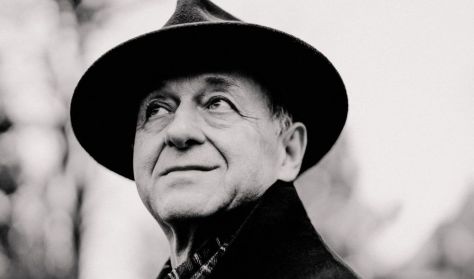
Brahms
The Budapest Festival Orchestra's Brahms series continues with a juxtaposition of grueling pursuit and easy success, as Hungarian dances precede weighty compositions. more

The Budapest Festival Orchestra's Brahms series continues with a juxtaposition of grueling pursuit and easy success, as Hungarian dances precede weighty compositions. more
Ön egy múltbeli eseményre keresett rá. Kérjük, válogasson aktuális kínálatunkból a Jegy.hu keresőjében!
Last event date on this page: Saturday, November 16 2024 3:30PM
Johannes Brahms: Hungarian Dance No. 1
Piano Concerto No. 1 in D minor, Op. 15
Hungarian Dance No. 11
Symphony No. 1 in C minor, Op. 68
Kirill Gerstein (piano)
conductor: Iván Fischer
This time, the spotlight is on the firsts: the series opens with the inaugural piece of the 21 dances, followed by the composer's grandiose Piano Concerto No. 1. After 10 spirited dances, Hungarian Dance No. 11, which opens the more lyrical section, sets the tone for Brahms' first symphony, liberated from the pressure of “writing a symphony after Beethoven.” The soloist of the concerto, the Russian-American Kirill Gerstein, is acclaimed by international critics as a profound and genuine character, a mesmerizing sound poet. One of today's most intelligent musical thinkers, he is guaranteed to discover something new and compelling in music.
Brahms published the piano four-hands edition of the 21 Hungarian Dances in two phases, over four volumes. Ede Reményi acquainted the composer with Hungarian Romani music, especially the “csárdás”, which inspired the dances Brahms called adaptations. The dances were an immediate success, but it was in their orchestral arrangements that they became really well-known. Among these orchestrations, only three originate from Brahms himself; one of them being the undulating Hungarian Dance No. 1, in which contrasts and musical jests take center stage. The melodies of the more melancholy Dance No. 11, played after the intermission, are Brahms' own. The piece is performed in Iván Fischer's orchestration.
Having heard Beethoven’s groundbreaking ‘Ninth’ in 1854, Brahms decided to write his own first symphony — following in Beethoven’s footsteps, in D minor. In the end, though, he turned his intended Symphony No. 1 into a sonata for two pianos, before reworking it in its entirety, and using parts of it in his Piano Concerto No. 1. The piece starts out incredibly dense and essentially tragic in its mood. A monumental orchestral exposition and a rich piano solo, at times truly competing with the tutti sound, characterize the opening movement. In the manuscript of the spiritual slow movement, which is most likely best interpreted as a portrait of Clara Schumann, the composer included the words, “Benedictus qui venit in nomine Domini” (Blessed is the one who comes in the name of the Lord). Finally, in the rondo-finale, a piano solo introduces the theme; later, the movement includes the only cadence of the piece, before concluding with a reverential, celebratory ending.
Finally completed in 1876 after initial attempts resulted in a piano concerto, Brahms’ Symphony No. 1 is often referred to as ‘Beethoven’s Tenth.’ Ultimately, the piece was composed in C minor, which alludes not to Beethoven’s Ninth, but to the similarly iconic Symphony No. 5. The impressive, slow opening of the first movement unwraps each of the themes that the fast-paced central passage builds on. The fundamentally dramatic movement is followed by a fluid, lyrical, and expressive slow movement, with violin solos laying the groundwork for the violin concerto. In the scherzo, gentle smiles are juxtaposed with almost arrogant forces, with a finale spanning from a sense of terror to the call of Alpine horns. In an homage to Beethoven’s Ode to Joy, the piece concludes with celebratory chorales.
Walk My World brings to life the tragic love story of Aeneas and Dido, an epic episode by the ancient Roman poet Virgil, where the mythic heroes of Troy and Carthage speak to you in the language of dance and contemporary circus. Step into a monumental space that engages all your senses, where a new reality unfolds before your eyes. Follow your own path and discover the legendary stories of the heroes. Step into a breathtaking realm where the games of gods, intrigue, and love fill every corner. Anything can happen: mysteries unravel, and enchanting characters draw you into their spell. Experience an ancient, mythic tale brought vividly to life through the artistry of contemporary circus and dance, in a modern and captivating form. Internationally renowned circus performers and dancers bring to life the gods, mortals, and fantastical creatures of myth.
A Monte Cristo grófja egy igazi, nagy ívű, romantikus musical. A történet ismert: nyüzsgő kikötő, a tenger hullámzása, régi-új szerelmek, esély egy új életre, őrült karneváli forgatag, intrika, bosszúvágy, elégtétel és Párizs, hol jobb és könnyebb az élet... mind-mind megelevenedik Alexandre Dumas világhírű regényének zenés színházi adaptációjában.
Candide, Kunigunda és Dr. Pangloss most a színpadon kelnek útra, és járják be a voltaire-i utakat Lisszabontól Eldoradoig. Groteszk humor,…
Az idén 22 éves Be Massive. Az elmúlt évek szilveszteri eseményei rendkívül népszerűek voltak, a jegyek pillanatok alatt elfogytak, ezért…
Megnyugtató, ha az ember szülei évtizedek után is békében, szeretetben élnek együtt. Szinte egyszerre lélegeznek, ismerik egymás minden mozdulatát, fel…

item(s) in basket
total:
Time limit has expired. Please, put item(s) in to basket again.